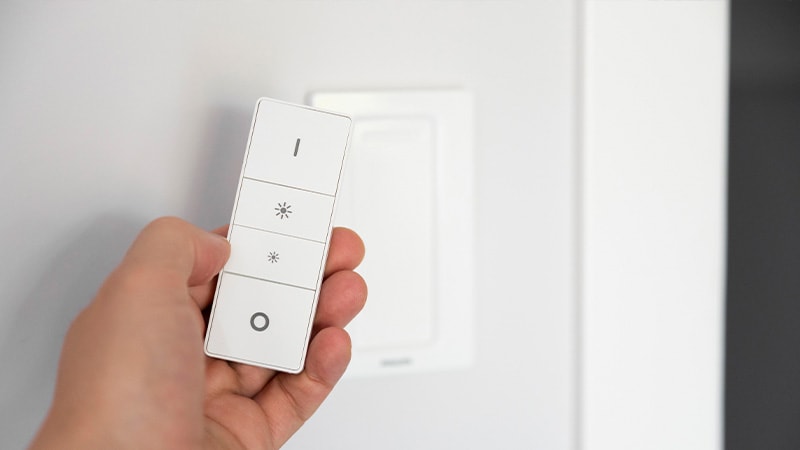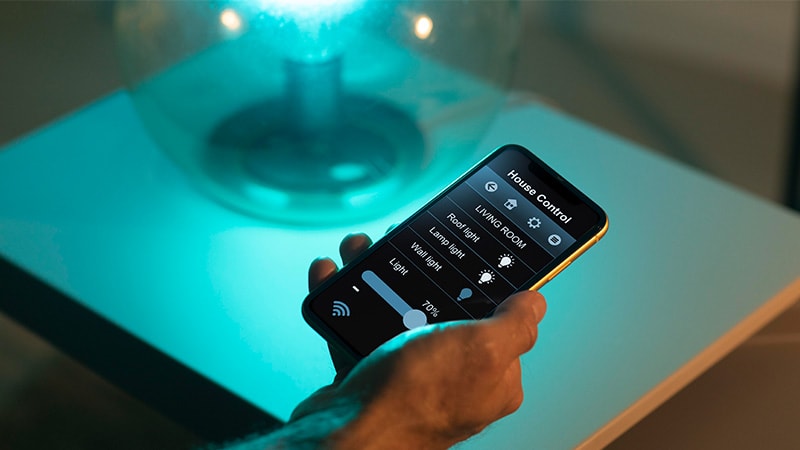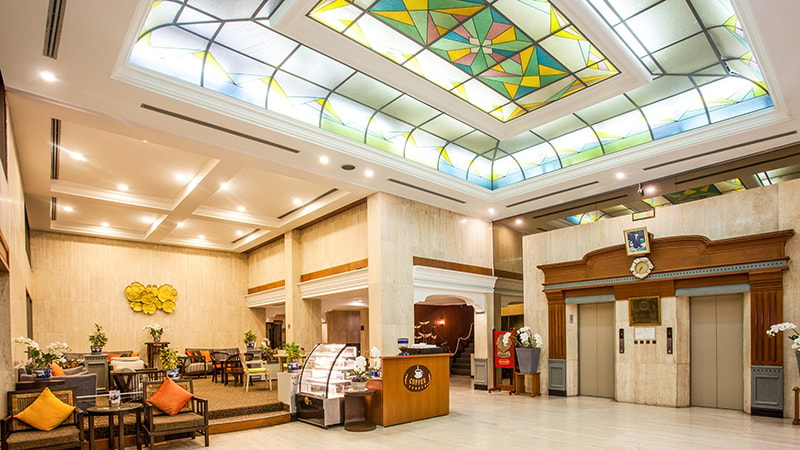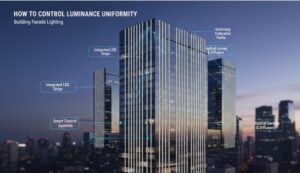Ambiance and experience reign king in the hospitality industry, and good lighting design has the biggest impact on guest satisfaction and loyalty. Using comprehensive and effective lighting control systems, owners can enhance the aesthetic appeal of hotel spaces, increase energy efficiency, and decrease operational costs.
In this article, we examine the core principles of lighting control systems, their benefits, and various types.
Understanding Lighting Control Systems
Lighting control systems consist of input and output devices that send and receive information from light fixtures and manage their power, brightness, and color temperature accordingly. Large-scale lighting control systems are commonly used in industrial and commercial applications. However, they have seen massive growth in the hospitality lighting sector.
Today’s Businesses can choose from diverse lighting control devices with automation capabilities and centralized lighting controls.
A typical hotel or resort has hundreds of light fixtures. A hotel can save energy by managing and optimizing those fixtures while ensuring a high guest experience.
4 Huge Benefits of Lighting Controls
Let’s discuss the various benefits of lighting controls to your hotel business.
1. Enhancing Guest Experience
In the hospitality industry, the customer is king. Guest satisfaction and experience determine the success of your business, and quality lighting plays a huge role in creating a welcoming atmosphere.
Customized hotel lighting allows you to control the lighting design in the different sections of the building.
- Bright, diffused lighting for the hotel lobby.
- Mood and accent lighting for dining areas.
- Flexible dimmable LED lights for hotel rooms.
2. Improving Energy Efficiency
No conversation about lighting control systems is complete without mentioning the energy costs of lighting fixtures. Lighting controls offer creative ways of reducing lighting energy consumption without disrupting the guest experience.
- Reduce the brightness of lights.
- Automatically turn on/off lights in response to sunlight.
- Sensors that detect when a person leaves the room and turns off the lights.
Lighting control systems can provide decent energy savings, helping you meet regional energy regulations and standards. A study by the California Lighting Technology Center shows that lighting control systems can reduce light power on time by up to 46%, which is a big factor in saving energy and keeping operational costs low.
3. Developing a Brand Identity
A unique lighting style is a great way to differentiate your hotel from the competition. Lighting control systems are the foundation for customized lighting that enhances the various sections of your hotel.
Use compelling lighting designs to create memorable experiences for the guests that can be tied to your hotel’s identity.
- Use accent lighting for your walls and hotel decor.
- Soft LED lights that mimic the colors of natural sunlight.
- Add underwater lights to your swimming pools and fountains.
- Adjust the brightness of ambient and accent lighting to balance visibility with energy consumption.
4. Automation and Hand-Off Operations
Automatic lighting controls are at the heart of hospitality lighting. Simply assign conditions to the control system and let it automatically manage your lights.
- No additional staff is required to manage lights.
- Easy and remote monitoring of hotel lights.
- Make changes to lighting design easily and in less time.
- Automatically turn lights on/off to reduce maintenance and energy costs.
| Automatic Lighting Control Systems | Manual Lighting Control |
| Remote Monitoring and Management of Fixtures | Easy to Install |
| Control Lighting using a Smartphone or Tablet | Very Low Investment Cost |
| Integration of Occupancy Sensors | Decentralized – Damage to one fixture has no impact on the others. |
| Reduce Energy Consumption | |
| Quickly Change or Modify Lighting Designs | |
| No Additional Staff Required to Monitory Hotel Lighting |
Types of Lighting Controls

Moving on to the question on everyone’s mind, “What can lighting controls even do?”
While we have discussed the value lighting control systems bring to your hotel, we haven’t touched on the different devices and techniques that make up a lighting control system.
Following is a list of the different types of lighting controls that you can deploy in your hotel.
| Lighting Controls | Applications |
| Manual Controls Controls | Low cost hand operated lighting changes. |
| Timer Switches Controls | Scheduled changes to lighting design. |
| Motion Sensors Controls | Automatic lighting control based on room occupancy. |
| Dimmer Switches Controls | Brightness controls for LED lights. |
| Photodetectors Controls | Changes indoor lighting based on daylight. |
| Color Temperature Controls | Control the hue of LED lights. |
| Wireless Controls | Control hotel lighting from wireless access points. |
| Network Controls | Manage several hotel functions through one system. |
1. Manual Lighting Controls
First, we must understand the old-school method of manual lighting control. Manual control systems use various hand-operated switches, dials, knobs, and levers that are hard-wired to lighting fixtures.
For example, a hotel building may have separate pool and restaurant lighting control panels. Workers can use that panel to manually shut off or dim lights after midnight to indicate that the amenities are closed for the day. While this process may sound tedious, there is beauty in its simplicity.
2. Timed Lighting Controls
Digital clocks don’t just tell you the time. They can also act as indicators for your lighting control systems. Modern lighting control systems provide scheduled power cycles that turn on/off your lights at desired times.
For example, outdoor lighting, such as parking, security, pathways, etc., can be turned on at sunset and off at sunrise. For 24-hour businesses like hotels, timer switches are a game-changer. The control system can schedule lights, leaving staff to attend to other duties at the hotel.
3. Occupancy/Motion Sensors
Experience the magic of modern technology. Step into a room and have the lights turn on without you ever lifting a finger. The secret behind this magic trick is occupancy sensors. They detect moving objects and bodies in a room using infrared lights and ultrasonic waves and turn the lights on.
Motion sensors and occupancy sensors operate on the same basic principle. Motion sensors are less sensitive and require large arm and body movements. They also turn off quickly if no significant motion is detected. Motion sensors are more cost-effective but can be frustrating for guests.
4. Dimming Control Systems
Dimmers are a flexible lighting control system that enables more versatile lighting design throughout the hotel. For safety and security reasons, let’s say you want to keep your hotel corridors constantly lit. Instead of running lights at full brightness, set them to 25-50% brightness during nighttime.
At night, guests don’t want to be blasted with bright lights. Hence, lighting dimming is a practical and profitable solution.
Dimming also plays a big role in ambiance-driven public spaces like restaurants, hotel bars, and outdoor lounge areas. For more on dimmers and dimming solutions, check out our breakdown of LED Dimming.
5. Photodetector Driven Controls
Photodetectors (also called photo sensors) are optical sensors that absorb light and convert it into electrical signals. Today, you can usually find them in outdoor light sensors that detect the intensity of natural sunlight.
Modern hospitality lighting involves using daylight for a more natural lighting design and switching to artificial light after sunset. Photodetectors measure the ambient daylight and adjust hotel lighting to complement the natural sunlight.
6. Color Temperature Control
Color-correlated temperature (CCT) measures the hue of artificial lights and is measured in Kelvins (K). Lower Kelvin values mean the light will have a warm-yellow hue, and higher values mean it will be cool-blue.
Cool lights increase focus and alert occupants, so they are used for meetings and conventions. By comparison, warm lights create a sense of comfort and relaxation, which is ideal for sitting and dining areas, where guests can relax and spend quality time.
7. Wireless Control Systems
Wireless lighting controls are the new kid on the block. Every major lighting manufacturer and service provider offers wireless solutions for lighting management. Wires are effective and reliable but are often limiting. Small changes to existing lighting controls require modifying old wiring, which costs time and money.
Wireless systems are versatile, flexible, and easy to install. They offer unparalleled convenience, especially when retrofitting older buildings. There is no need to deal with cumbersome old wiring; install new fixtures and control panels to the existing power line and wirelessly control your lights.
Modern solutions can be integrated with smartphone apps for easy monitoring and finer lighting controls.
8. Unified (Networked) Lighting Control Systems
Hotel management systems have gotten more expansive with the growth of smart devices. Centralized control systems enable seamless integration of different lighting controls into one big network. You can
This setup gives operators complete control over lighting controls from multiple buildings, campuses, and hotel areas from a single location. Unified solutions also help tie indoor/outdoor lighting, emergency lighting, security cameras, sound systems, and intercoms together for convenience.
All new hotels and resorts use networked lighting controls for illumination and other building management systems.
Wired vs. Wireless Lighting Control System

Wired systems use low-voltage signals to transmit information between devices. They are incredibly reliable and long-lasting. However, wired systems can be quite limiting. You can only monitor your lights from designated control panels, and changes to the system require expensive rewiring.
Wireless systems connect to light fixtures using Wi-Fi and Bluetooth protocols, enabling remote and convenient monitoring and management controls. These solutions are easy to install as they don’t require complex wiring and offer more comprehensive real-time monitoring of individual lights. However, they are susceptible to hacking attacks.
Additionally, most wireless solutions use proprietary technology, meaning you can only buy replacement parts from a designated supplier. If that supplier goes out of business or stops selling compatible products in the future, you will have to invest in a new lighting control system.
| Wired Lighting Controls | Wireless Lighting Controls |
| Advantages | |
| Higher Reliability | Remote Access using Smartphone |
| Long Lasting | Retrofitting Capabilities |
| Lower Investment Cost | Lower Installation Cost |
| Lower Cost of Operation | More Detailed Monitoring Options |
| Control and Manage Lighting from Anywhere | |
| Disadvantages | |
| Easy to Add New Devices to the System | Easy to Add New Devices to System |
| Monitoring is Only Possible from Select Locations | Prone to Hacking |
| Labor Costs for Wiring Installation are Very High | Proprietary Technology |
Popular Lighting Control Solutions for Your Hotel
Now that we have discussed the capabilities of lighting control systems, let’s move on to industrial solutions at the back end of these control systems.
1. Analog Solutions
Although outdated by modern standards, the 0-10v system is a simple and effective analog lighting control system. A specialized switch sends low-voltage inputs (zero to ten volts) to the light fixture. Zero volts mean fully dimmed lights, and ten volts mean maximum brightness.
Analog lighting controls are excellent for controlling individual illumination in a hotel room but are unsuitable for lighting throughout a building.
2. Digital Solutions
Digital lighting control systems rely on smart controllers that use modern microprocessors to send and receive information.
DMX512
DMX (digital multiplexing) is a popular centralized lighting control system that allows users to control up to 512 light fixtures. Starting as a theater management tool for lights, fog machines, and special effects, it quickly gained popularity as a comprehensive lighting control system for large buildings.
It lacks native support for sensors but supports daisy chaining (one fixture is connected to the controller, and the rest can be connected to the fixture).
DALI
DALI (Digital Accessible Lighting Interface) is a two-way lighting control protocol that can connect to several light fixtures and control them individually. A big benefit of DALI is its native support for sensors like dimmers, touchpads, motion sensors, etc.
Manufacturers looking to develop DALI-compatible products must first register with the DALI Alliance (DiiA).
To learn more about DMX and DALI, check out our in-depth comparison of their technologies.
3. Wireless Solutions
Wireless lighting solutions use standard protocols like Bluetooth, Zigbee, and Wi-Fi to send and receive information from light fixtures. One big benefit of wireless solutions is the ability to control your hotel lighting using a smart device (phone, tablet, laptop).
In both cases, you must buy light fixtures from one manufacturer, as the smartphone apps will only work with their hardware.
Bluetooth solutions use less power and require proximity to the control panels within 100 meters. In contrast, Wi-Fi solutions allow you to control the lighting system from anywhere worldwide as long as you have an internet connection.
DALI now offers a wireless control system that runs on Bluetooth and Zigbee technology.
4. Custom Solutions
Many local companies offer customized lighting solutions using open-source or proprietary lighting control protocols. They offer wired and wireless options requiring custom software and hardware.
These solutions are purpose-built for the client and offer a completely customized hospitality lighting system that best suits your business. Local suppliers can also offer regular on-site maintenance services.
However, these systems are locked down by the supplier. Changing suppliers will result in a complete overhaul of your lighting controls…
The Most Effective Approach to Hotel Lighting

You must develop a comprehensive lighting plan before investing in an expensive hotel lighting setup. Here are three simple steps that will help you optimize your hotel lighting.
Step 1 – Designing an Effective Lighting Control System
Designing involves assessing your hotel lighting needs and aesthetic preferences.
- Balance your functional needs with your aesthetic desires. The system should be easy to use and maintain while aligning with your visual tastes.
- Look for sustainable lighting solutions to decrease your hotel’s carbon footprint.
- Create customized lighting scenes for the different areas of your hotel. Focus on guest experience and stay within your power budgets (energy savings).
- Integrate other hotel systems with your lighting controls. See if you can get a unified building management system that controls air conditioning, lighting, communications, etc.
Step 2 – Implementing a Lighting Control System in Your Hotel
Implementation involves verifying your lighting design meets the hotel’s needs.
- Plan your lighting control layout, including locations for control panels, wiring runs, and fixture requirements. Ensure that the system stays within budget while meeting your lighting needs.
- Estimate the installation time and costs. Hire contractors to check if the system operates as intended.
- Account for hotel staff training and support overhead. Your staff should be able to operate the system easily and perform minor maintenance duties.
Step 3 – Maintaining and Upgrading Your Hotel’s Lighting Control System
Maintenance is very important when hundreds or thousands of lights are installed in a building.
- Perform regular maintenance checks to ensure all devices are operational.
- Prioritize troubleshooting issues over repairing and replacement.
- Upgrade your lighting control with newer energy-efficient technologies and devices.
- Prepare to expand your system to meet the hotel’s growing needs.
- Ensure compliance with regional energy codes, regulations, and standards.
Choosing the Right Lighting Control Supplier for Your Hotel
A thorough assessment of your hotel needs and detailed budget will help you easily narrow down the tight lighting control systems provider.
Assessing Your Hotel’s Lighting Needs
Identify areas for improvement in your hotel’s current lighting system. Outline your lighting requirements and choose a lighting control system that best suits your hotel’s needs.
Evaluating Suppliers and Products
Always look for trustworthy and established suppliers and service providers. Research the biggest players in the lighting control space and evaluate the features and benefits of their different products.
Considering Budget and ROI
Implementing a new lighting control system in your hotel is a major decision. Make a detailed budget beforehand and estimate the potential return on investment (ROI) period for different lighting control system suppliers.
Conclusion
Modern hotels are larger than ever, incorporating restaurants, golf courses, pool areas, spas, and other spaces into one massive experience. At such a scale, hotels use hundreds, if not thousands, of light fixtures that need constant monitoring, management, and maintenance. The need for a comprehensive lighting control system is evident. It optimizes the lighting throughout the hotel space and ensures minimum energy is consumed to meet the illumination requirements. Additionally, automation ensures your hotel staff spends less time inspecting light fixtures and more time attending to guest needs.
Illuminate Your Hotel with RC Lighting!
RC Lighting is a pioneer in the Architectural LED Lighting Industry. For over a decade, we have been manufacturing high-quality sustainable lighting. Our commitment to product innovation and customer satisfaction has allowed us to forge long-lasting partnerships with an international clientele.
All our products go through rigorous testing and are ISO9001-certified. Our premium Indoor LED Lights are compatible with modern lighting control systems and designed to enhance the look and feel of your hotel.
Please take advantage of our exceptional 5-year warranty and light up your hotel with RC Lighting.



